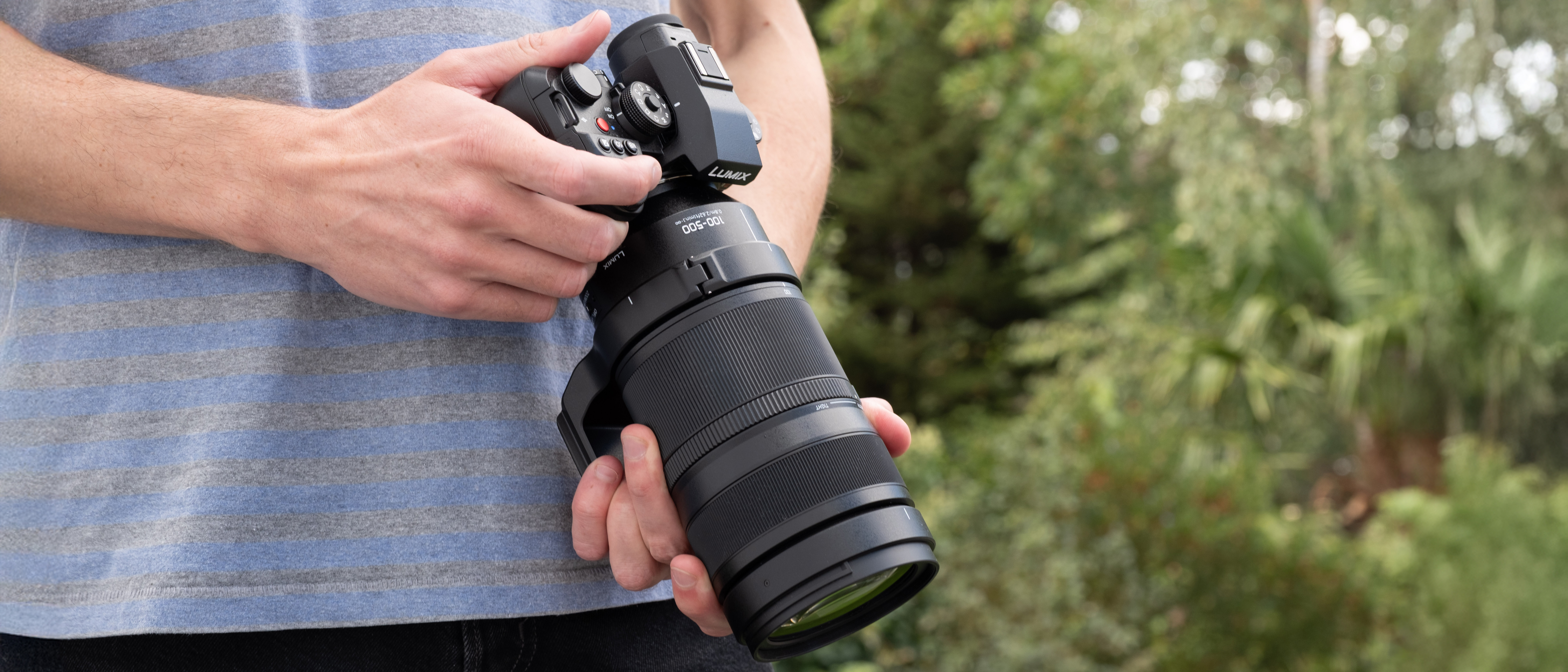By Gareth Bevan
Copyright digitalcameraworld

Skip to main content
Close main menu
Digital Camera World
THE HOME OF DIGITAL PHOTOGRAPHY
View Profile
Search Digital Camera World
Accessories
Buying Guides
The Photography & Video Show
Digital Camera
Australian Camera
Australian ProPhoto
Photography Magazines
Why subscribe?
Issues filled with product reviews, latest updates, expert advice and more
Delivered to your Android or IOS device
Every issue is packed with photo tips, kit reviews and inspiration
From$12Subscribe now
Camera news
Camera rumors
Photography & Video Show
Cheatsheets
Photo mag deals
Prime Day deals
Don’t miss these
Hands-on OM System M.Zuiko 50-200mm f/2.8 IS Pro review: The world’s only 100-400mm f/2.8 equivalent lens!
Best lenses for the Panasonic Lumix S9 in 2025
360 Cameras
DJI Osmo 360 review – the new king of 360-degree cameras on the first try?
Compact Cameras
Sony RX1R III review: Size matters… and this tiny 61MP compact camera is the pound-for-pound champ
The best lenses for the Fujifilm X-S10 and X-S20: find the ideal fit in terms of size and price
The best Olympus and OM System lenses: great glass for Micro Four Thirds cameras of any brand!
Hands-on Canon RF 85mm f/1.4L VCM review: Canon’s long-awaited portrait prime gets a hybrid makeover
LK Samyang AF 35mm f/1.4 P FE review: it’s Prima prime time for Sony shooters
The best camera for wildlife photography: for the best bird and animal photos, you need the right kit!
Mirrorless Cameras
Hasselblad X2D II 100C review: The finest stills camera ever made
The best lenses for bird photography and wildlife: these lenses really go the distance
The best lenses for safari photography: get close to wildlife while maintaining a respectful distance
Compact Cameras
Canon PowerShot SX740 HS / Lite review: Canon’s best photo-focused compact camera?
Digital Cameras
The best medium format cameras: 100MP monsters for supreme image quality
Best lenses for the OM System OM-5 Mark II: This is the glass you need for OM’s compact outdoor camera
Panasonic Lumix S 100-500mm f/5-7.1 O.I.S. review: a super zoom
This lightweight and compact superzoom comes with very little compromise
Gareth Bevan
25 September 2025
When you purchase through links on our site, we may earn an affiliate commission. Here’s how it works.
(Image: © Gareth Bevan / Digital Camera World)
Digital Camera World Verdict
Outstanding image stabilization and excellent image quality should put this on the wishlist of wildlife and sports enthusiasts. It’s not small – but the lens is impressively compact and lightweight for its focal range; it’s not too much of a chore to fit into a camera bag. The only letdown is the new smooth-tight ring, which, as far as I could tell, had very little effect on the zoom speed.
Check Amazon
Check Walmart
Image stabilization is outstanding
Great image quality throughout the zoom range
Light and compact for the focal range
Smooth-tight ring doesn’t make much of a difference
Best picks for you
The best lenses for Panasonic Lumix S5, S5 II and S5 IIx cameras: ideal fits for size and price
The best L-mount lenses: check out these best buys for your Panasonic, Sigma or Leica mirrorless camera
The best 150-600mm lenses: super-telephoto zooms to get close to the action
Why you can trust Digital Camera World
Our expert reviewers spend hours testing and comparing products and services so you can choose the best for you. Find out how we test.
Specifications
Design & Handling
Performance
Sample Gallery
Video Performance
Lab results
Alternatives
Superzoom lenses often get a bad rep in professional circles. Compared to primes, they’re routinely accused of being compromised with slower apertures, softer corners, bulkier build –but the appeal of a single lens capable of covering everything from mid-tele to full reach is hard to ignore, especially for wildlife, travel or sports shooters.
The Panasonic Lumix S 100-500 mm f/5-7.1 O.I.S. arrives not to replace primes, but to challenge if a superzoom really perform well enough to make you rethink carrying multiple lenses?
In a market where rivals such as Sigma’s 100-400mm and 150-600mm zooms already offer solid performance, this new Lumix promises a more portable, lighter alternative in the L-mount ecosystem. With improved optical image stabilisation, new Lumix lens features like a tight-smooth ring, and a notable focal range, can this lens convince you to leave your primes at home?
(Image credit: Gareth Bevan / Digital Camera World)
Lumix S 100-500mm f/5-7.1: Specifications
Swipe to scroll horizontally
Lens construction
19 elements in 12 groups
Optical Image Stabilization
Diaphragm blades
Minimum Aperture
Minimum focus distance
0.8m (100mm), 1.5m (500mm)
Maximum magnification
0.16x (100mm), 0.36x (500mm)
Filter size
196.1 mm (L) x 92 mm (D) / 7.72 in (L) x 3.62 in (D)
1,285 g / 2.83 lbs
Lumix S 100-500mm f/5-7.1: Price
At $2,099 / £1,799, the Lumix S 100-500mm is very reasonable compared to similar focal length/aperture combinations from other camera brands, and still well within enthusiast territory. However, Sigma does offer two excellent competitors in L-mount for significantly less money. The Sigma 100-400mm f/5-6.3 DG DN OS costs just $1,049 / £899, while the Sigma 150-600mm f/5-6.3 DG DN OS is $1,649 / £1,249.
I’ll go deeper into this in the next section, but the new Lumix S lens beats both these Sigma options if you value weight and size above price, with the Lumix being significantly smaller and lighter than even the Sigma 100-400. If you want the lightest kit possible, then you’ll likely find the extra cost of the Lumix is worth every penny.
Today’s best X100VI deals
$1,599Preorder
$1,799View
$2,129.99View
We check over 250 million products every day for the best prices
Lumix S 100-500mm f/5-7.1: Design & Handling
I hesitate to call the 100-500mm lens small, as it’s still a hefty bit of kit at 1,285g (2.83lbs) and 196.1mm (7.72in) long – but compared to rivals, it’s a significant difference. Sticking with L-mount cameras, the closest two competitors are the Sigma 100-400mm f/5-6.3 DG DN OS, which, despite being 100mm shorter in maximum focal length, weighs an almost comparable 1,135g (2.5lbs) and measures 197.2mm (7.76in) in length. Meanwhile, the Sigma 150-600mm f/5-6.3 DG DN OS weighs a whopping 2,100g (4.63lbs) and is 279.2mm (10.99in) long. Although both these lenses have a stop wider aperture at the top end.
Glancing beyond the L-mount for just a second, the closest any other brand comes is Canon’s RF 100-500mm f/4.5-7.1 L IS USM lens, which is marginally heavier and longer (1365g / 207.6mm), although it does have a slightly wider aperture at 100mm.
Get the Digital Camera World Newsletter
The best camera deals, reviews, product advice, and unmissable photography news, direct to your inbox!
Contact me with news and offers from other Future brandsReceive email from us on behalf of our trusted partners or sponsorsBy submitting your information you agree to the Terms & Conditions and Privacy Policy and are aged 16 or over.
The Lumix 100-500mm is an impressive feat from Panasonic’s engineers – and will be a very welcome one to those sick of lugging around wildlife or sports kit.
Image credit: Gareth Bevan / Digital Camera World
Image credit: Gareth Bevan / Digital Camera World
The fit and finish on the lens itself feels very premium. It’s weather sealed at various potential ingress points, so it can survive a trip out in the rain, some sea spray, or dusty conditions. It can also be used down to -10ºC (14ºF), should you want to take it on your next arctic expedition. The lens also comes with a hood and solid metal tripod foot compatible with Arca-Swiss plates, and allows the camera to be quickly rotated between landscape and portrait shooting.
Around the barrel, switches include a full-time manual focus switch, a focus limiter switch, and a switch to swap between the two optical image stabilisation modes on the lens, with mode one being standard stabilisation and mode two for panning. There is also a custom switch a third of the way down the barrel. By default, this is set to control the camera’s hybrid zoom function, but this switch is customizable to a number of quick settings selectable in the camera’s menu.
The lens also has a zoom limit function, which, when turned on, stops the lens from creeping below 150mm, and can help with speeding up zooming through the entire range and consistent framing. It’s an incredibly useful feature, especially for birders, but I’d love to see this improved by being able to manually change the locked focal length, as at times I’d have liked to have locked it higher than the 150mm base.
Image credit: Gareth Bevan / Digital Camera World
Image credit: Gareth Bevan / Digital Camera World
New for an S Series lens is a Tight-Smooth ring, which should set the dampening of the zoom ring to either Tight, for precise control of micro-adjustments, or Smooth for quickly zooming through the range, perfect for erratically moving subjects. However, I couldn’t really feel the difference between the two modes. The lens just always felt a bit tight to me, and I would have loved the smooth setting to actually let me quickly fly through the focal range.
I also prefer Sony’s Tight-Smooth implementation, with it being a one-or-the-other switch rather than the Tight-Smooth ring, which did get easily knocked out of its set position while I was using the camera, and with very little difference between smooth and tight, having a graduated scale between them is fairly meaningless.
Lumix S 100-500mm f/5-7.1: Performance
The optical quality of the lens is excellent, for any lens this would be a great performance, let alone for its impressively compact size, weight, and the zoom range it manages to cover. Centre sharpness is excellent from 100mm all the way up to 500mm. Wide open, some softness creeps into the corners as you go up through the zoom range, but it’s not hugely noticable unless you’re looking for it.
The background blur wide open is really pleasing. With this lens compression, especially the further you zoom in, the background fall off from your subject just melts away.
The lens (combined with the in-camera corrections) also does a great job of controlling color fringing, distortion and vignetting – with none being visible in my real-world testing.
(Image credit: Gareth Bevan / Digital Camera World)
(Image credit: Gareth Bevan / Digital Camera World)
Panasonic’s image stabilisation has long been one of the best in the business, but somehow it continues to improve while becoming even more compact.
The new optical image stabilisation unit in the lens is phenomenal. The sample video in the section below was shot entirely handheld using a combination of the lens’s optical stabilization and Panasonic’s excellent standard electronic stabilization.
At 500mm, shots were rock steady, and I could even pan smoothly, the lens doing an excellent job of compensating for the direction of movement. This stability also makes such a difference just in the EVF for framing a shot or tracking a subject.
(Image credit: Gareth Bevan / Digital Camera World)
(Image credit: Gareth Bevan / Digital Camera World)
Autofocus is very quick and silent, pulling from near to far incredibly quickly. Panasonic’s autofocus still isn’t quite up to Canon and Sony’s when tracking subjects, but it’s still did a decent job of picking out animals bodies and eyes, although was a little bit skittish in tracking movement.
(Image credit: Gareth Bevan / Digital Camera World)
Lumix S 100-500mm f/5-7.1: Sample Gallery
Image 1 of 18
(Image credit: Gareth Bevan / Digital Camera World)
(Image credit: Gareth Bevan / Digital Camera World)
(Image credit: Gareth Bevan / Digital Camera World)
(Image credit: Gareth Bevan / Digital Camera World)
(Image credit: Gareth Bevan / Digital Camera World)
(Image credit: Gareth Bevan / Digital Camera World)
(Image credit: Gareth Bevan / Digital Camera World)
(Image credit: Gareth Bevan / Digital Camera World)
(Image credit: Gareth Bevan / Digital Camera World)
(Image credit: Gareth Bevan / Digital Camera World)
(Image credit: Gareth Bevan / Digital Camera World)
(Image credit: Gareth Bevan / Digital Camera World)
(Image credit: Gareth Bevan / Digital Camera World)
(Image credit: Gareth Bevan / Digital Camera World)
(Image credit: Gareth Bevan / Digital Camera World)
(Image credit: Gareth Bevan / Digital Camera World)
(Image credit: Gareth Bevan / Digital Camera World)
(Image credit: Gareth Bevan / Digital Camera World)
Lumix S 100-500mm f/5-7.1: Video Performance
Lumix S 100-500mm f/5-7.1: Lab results
We run a range of lab tests under controlled conditions, using the Imatest Master testing suite. Photos of test charts are taken across the range of apertures and zooms (where available), then analyzed for sharpness, distortion and chromatic aberrations.
We use Imatest SFR (spatial frequency response) charts and analysis software to plot lens resolution at the center of the image frame, corners and mid-point distances, across the range of aperture settings and, with zoom lenses, at four different focal lengths. The tests also measure distortion and color fringing (chromatic aberration).
(Image credit: Future)
(Image credit: Future)
Center sharpness is excellent at 100mm, even wide open at f/5, and though slightly less impressive at longer focal lengths, it’s still very good. Corner sharpness is more mediocre, but at least its quite consistent, regardless of focal length or aperture.
(Image credit: Future)
Even without automatic in-camera correction enabled, color fringing is impressively low at all focal lengths.
Distortion:
(Image credit: Future)
There’s consistent pincushion distortion at all focal lengths, but it’s minimal.
Lumix S 100-500mm f/5-7.1: Verdict
The Panasonic Lumix S 100-500mm f/5-7.1 O.I.S. proves that a superzoom doesn’t have to mean big compromises. Its headline feature is outstanding image stabilization, delivering up to seven stops of compensation that makes handheld shooting at extreme focal lengths genuinely viable. Image quality holds up impressively too, remaining sharp and consistent right through the zoom range.
What’s most surprising is how portable it feels. At this reach, Panasonic has kept things impressively light and compact, making it practical for throwing in a bag for travel, wildlife safaris, or sports. But it’s not flawless – the new smooth-tight zoom ring offers little noticeable difference in operation.
Still, for L-mount users looking for reach without investing in multiple primes or lugging a 150-600mm monster, this lens neatly fills the gap.
Swipe to scroll horizontally
Huge 100–500mm range, 7 stop O.I.S., smooth-tight ring, custom button and weather-sealing make this a very rounded package.
Premium feeling, and more compact and lighter than L-mount rivals, though the smooth-tight zoom ring doesn’t deliver.
Performance
Sharp images throughout the range, excellent stabilisation and reliable autofocus for stills and video.
Pricier, but a much lighter and more compact alternative to heavier 150–600mm zooms.
(Image credit: Gareth Bevan / Digital Camera World)
Alternatives
If you want the absolute longest focal length in one single lens, then look no further than the Sigma 60-600mm f/4.5-6.3 DG DN OS Sports. This lens is big and bulky, but you might find it’s the only lens you need to fit into your bag.
Read our full Sigma 60-600mm f/4.5-6.3 DG DN OS Sports review
The Sigma 100-400mm f/5-6.3 DG DN OS Contemporary has a smaller zoom range, but it is quite a bit cheaper than the Lumix S 100-500mm. However, the Lumix is comparable in size and weight, despite being 100mm longer!
Read our full Sigma 100-400mm f/5-6.3 DG DN OS Contemporary review
Panasonic Lumix S 100-500mm f/5-7.1 O.I.S.: Price Comparison
No price informationCheck Amazon
No price informationCheck Walmart
We check over 250 million products every day for the best prices
powered by
Gareth Bevan
Social Links Navigation
Reviews Editor
Gareth is a photographer based in London, working as a freelance photographer and videographer for the past several years, having the privilege to shoot for some household names. With work focusing on fashion, portrait and lifestyle content creation, he has developed a range of skills covering everything from editorial shoots to social media videos. Outside of work, he has a personal passion for travel and nature photography, with a devotion to sustainability and environmental causes.
You must confirm your public display name before commenting
Please logout and then login again, you will then be prompted to enter your display name.
Panasonic Lumix S 70-300mm f/4.5-5.6 Macro O.I.S. review: a tele zoom like manufacturers used to make, but better
Sigma 300-600mm f/4 DG OS Sports review: Sigma’s supersize “dream lens” is now a reality
Sample photo and video gallery: How good is the new Panasonic Lumix S 100-500mm f/5-7.1 O.I.S. supertelephoto zoom?
Hands-on OM System M.Zuiko 50-200mm f/2.8 IS Pro review: The world’s only 100-400mm f/2.8 equivalent lens!
Canon RF 600mm f/4L IS USM review: Pricey yet indispensable optic for professional sports and wildlife photographers
Panasonic Lumix S1IIE review: the powerful pedestrian
Latest in Lenses
Ultra-light, ultra-cheap fisheye prime launched: Brightin Star 10mm f/5.6 Pro APS-C
Panasonic’s longest S series zoom promises “industry-leading” stabilization and a new smooth-tight tension ring
Sample photo and video gallery: How good is the new Panasonic Lumix S 100-500mm f/5-7.1 O.I.S. supertelephoto zoom?
The new Sigma 135mm f/1.4 and 20-200mm f/3.5-6.3 are already so popular, some orders are delayed
Best lenses for the Fujifilm GFX 100S II
Nikon announces Z Cinema lenses – here’s what to expect
Latest in Reviews
DJI Osmo Nano review – pro power, smaller than a GoPro, and you can wear it? Is this the future?
MSI Creator A16 AI+ laptop review
Atli ATL4500 4K review: a specialized timelapse camera for long-term projects
GoPro Max 2 review – first hands on experience with the Max 2
Panasonic Lumix S 100-500mm f/5-7.1 O.I.S. review: a super zoom
ATLI X10 review: this 4K timelapse camera’s got a real lens and everything!
LATEST ARTICLES
Anker has Kickstarted the world’s first mobile movie theatre with surround sound – and it looks amazing!
I was totally surprised by this “levitating” webcam microphone – new Wave is an unexpected play from Insta360 right now!
Nikon’s amazing hybrid global and rolling image sensor offers best of both worlds
The Canon EOS R1 isn’t a camera – it’s a supercomputer that takes photographs
This year, I have shot more photography with my phone than with my camera
Digital Camera World is part of Future US Inc, an international media group and leading digital publisher. Visit our corporate site.
Terms and conditions
Contact Future’s experts
Privacy policy
Cookies policy
Advertise with us
Accessibility Statement
Future US, Inc. Full 7th Floor, 130 West 42nd Street,
Please login or signup to comment
Please wait…



